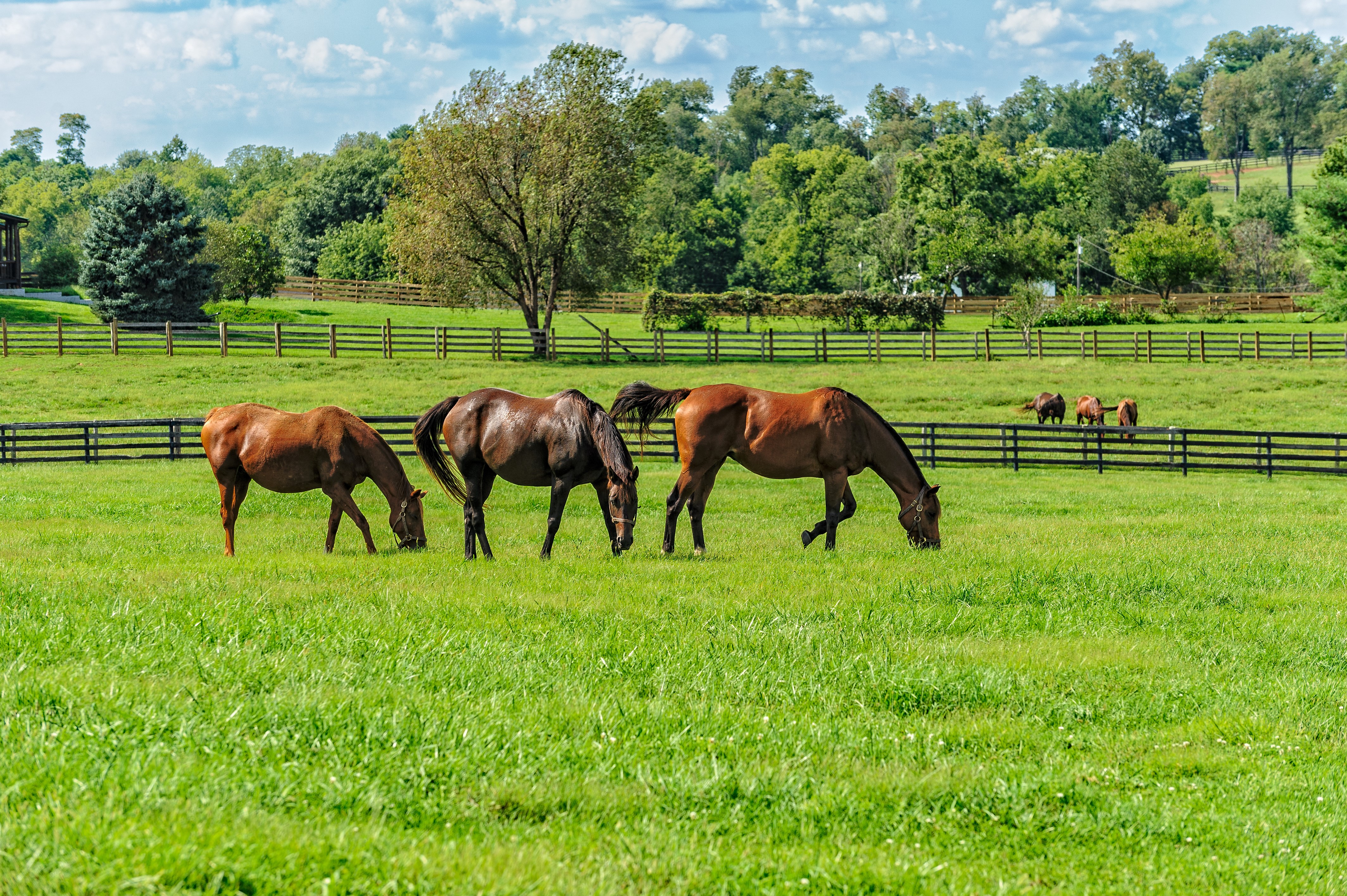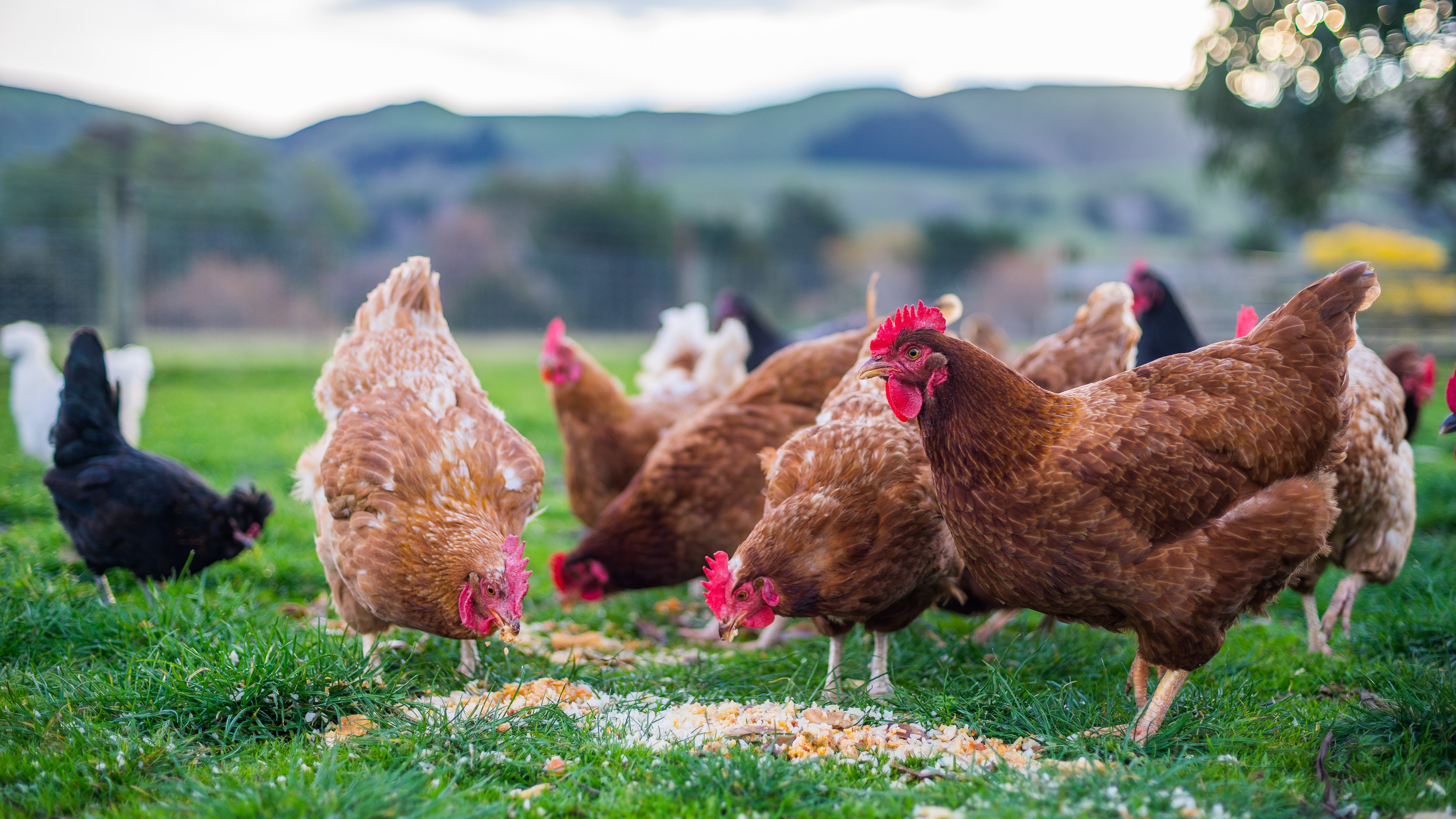Lamb liver fluke antibody test results - 2022
Lamb Liver Fluke Antibody Test Results - 2022
Using abattoir blood samples from slaughtered lambs to detect the timing & spread of fluke infection
Since 2015, from June to December, DAFM has taken lamb blood samples in factories from a proportion of flocks at the time of slaughter. These have been tested for liver fluke antibodies to determine the timing and geographical spread of liver fluke challenge to grazing lambs.
The number of flocks selected for sampling from each county is intended to be proportionate to the sheep population of that county over the entire sampling period (i.e July to November 2020). A number of samples are taken from each selected flock, and these are pooled at laboratory level. The presence of liver fluke antibodies reflects the level of challenge the lambs have experienced during the most recent grazing season. The presence of liver fluke antibodies in 2022 born lambs is therefore a sentinel for exposure to liver fluke in the wider sheep population in the region, as by definition these lambs must have been exposed during the 2022 grazing season.
Results for the country, for the 2022 Fluke testing season, are as follows:
|
Date |
Total Flocks Tested |
Positives |
% Positives |
|
July ‘22 |
130 |
11 |
8.46% |
|
August ‘22 |
224 |
59 |
26.3% |
|
September ‘22 |
175 |
58 |
33.1% |
|
October ‘22 |
176 |
87 |
49.4% |
|
November ‘22 |
186 |
95 |
51.1% |
Please see maps in Figure 1 below for more detail on the distribution of positive, negative and inconclusive results.
What are liver fluke?
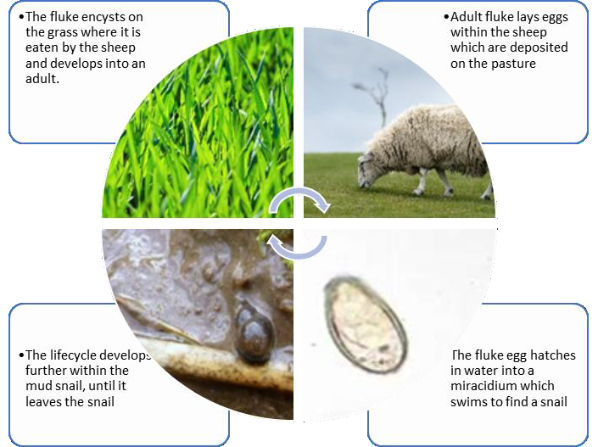
Liver Fluke Life cycle
Liver fluke are a parasite, affecting mainly sheep and cattle, which thrives in our damp climate. They have a fairly complex lifecycle including a primary host, where the adult fluke lives and an intermediate host where the immature stage of the fluke develops. The adult stage of liver fluke is a leaf shaped flat worm which resides in the liver of the primary host, in Ireland this is normally sheep or cattle however other species are also susceptible to infection. In this case we are focusing on sheep. The adult fluke takes 10 – 12 weeks to mature when within the sheep and then produces eggs which are excreted from the sheep on to the pasture. For the eggs to hatch out on the pasture they need moisture and temperatures in excess of 10°c. Due to this, eggs may lie dormant over winter and hatch in the spring when conditions are correct. The warmer the weather the faster the eggs mature so often this results in large volumes of eggs which have survived over winter hatching at the same time. The fluke eggs hatch into their next developmental stage, the miracidium which is a mobile larval stage which requires a water film to move. The miracidium swim about in search of the intermediate host, the mud snail. This is a necessary part of the lifecycle so without the mud snail the miracidium will die off. The mud snail involved in the life cycle of liver fluke also requires moisture and temperatures over 10°c to survive. This means that the life cycle of the liver fluke can only be completed if the conditions are correct for the survival of the mud snail. It also means that if we have a particularly mild winter instead of being killed off a large volume of the snails can survive making the spring fluke in our livestock worse. Once the miracidium enters the mud snail it undergoes further developmental changes. The time this takes is dependent on the environmental temperature, so it takes a longer time if temperatures are cold but happens faster when the conditions are warm, 6 – 8 weeks in ideal conditions. If the mud snail is infected in the autumn time most are killed off in the cold weather but some snails can hibernate and survive. The number this occurs in is small and doesn’t pose a significant infection risk to the sheep unless we have a very mild wet winter. Whilst inside the mud snail the miracidium goes through further development to become cercariae. These leave the mud snail and swim onto foliage where the lose their tails and form cysts on the grass. The encysted stage of the liver fluke cycle is resistant to freezing so can survive over winter on the pasture. The grass with the cysts on it is then eaten by the sheep. It develops into a juvenile fluke within the intestine and burrows through the intestinal wall into the liver of the sheep where it matures and completes its lifecycle.
Fluke season 2022
The 2022 season started as a small percentage of positive flocks mainly concentrated in the north-west of the country. This slowly moved eastward towards the midlands with a few pockets of positive cases seen in the east and south. When compared with the weather for the corresponding time this makes sense as the south and east saw warm and dry weather with reduced average rainfall up until the end of August thus limiting the availability of suitable habitat for the intermediate host, the mud snail. Into October and November, higher percentages of positive fluke cases were recorded over a far larger part of the country, moving both east and south. This was in conjunction with a mild wet September to November in 2022 which increased the availability of suitable habitat for the intermediate host of the liver fluke.
July 2022
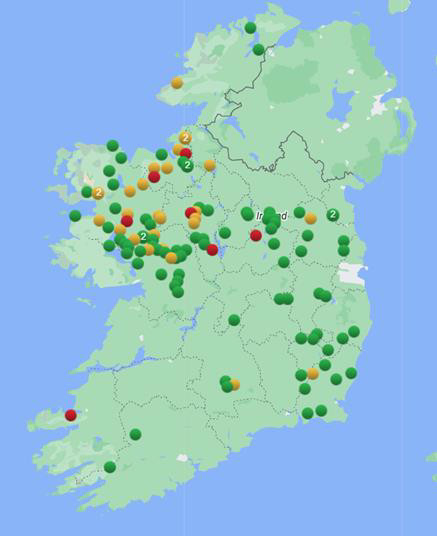

Samples from 130 flocks were submitted, of which 11 were positive and 26 were inconclusive. Of the positive samples 1 was heavy infestation, 1 moderate infestation and 9 low grade infestation. The 11 samples were distributed across counties Mayo (2), Kerry (1), Galway (1), Meath (1), Roscommon (2), Sligo (3) and Westmeath (1). The 26 inconclusive results came from flocks in counties Galway (4), Roscommon (3), Sligo (4), Mayo (10), Donegal (1), Meath (1), Tipperary (1), Leitrim (1), and Wexford (1).
August 2022


Samples from 224 flocks were submitted, of which 59 were positive and 17 were inconclusive. Of the positive samples 7 were heavy infestation, 14 moderate infestation and 38 low grade infestation. The 59 samples were distributed across counties Donegal (11), Galway (14), Kerry (1), Leitrim (2), Longford (2), Mayo (15), Monaghan (2), Offaly (1), Roscommon (2), Sligo (3), Westmeath (1) and Wicklow (5). The 17 inconclusive results came from flocks in counties Donegal (1), Galway (6), Mayo (4), Meath (1), Offaly (1), Roscommon (2), Sligo (1) and Wexford (1).
September 2022
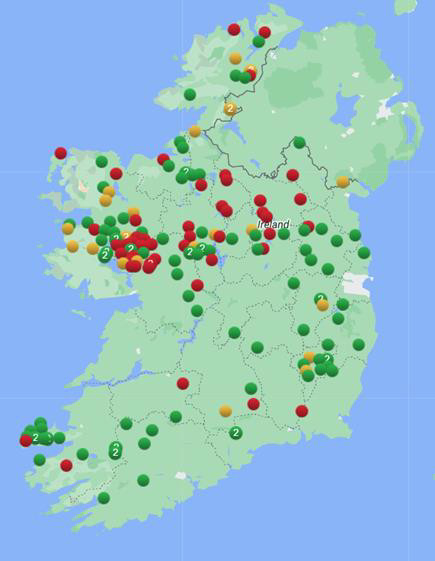

Samples from 175 flocks were submitted, of which 58 were positive and 21 were inconclusive. Of the positive samples 3 were heavy infestation, 22 moderate infestation and 33 low grade infestation. The 58 samples were distributed across counties Cavan (4), Donegal (5), Galway (17), Kerry (3), Leitrim (4), Limerick (1), Longford (1), Mayo (10), Meath (1), Monaghan (1), Roscommon (5), Sligo (1), Tipperary (1), Westmeath (2), Wexford (1) and Wicklow (1). The 21 inconclusive results came from flocks in counties Carlow (1), Donegal (3), Galway (4), Kildare (1), Leitrim (1), Longford (1), Louth (1), Mayo (5), Roscommon (2) and Tipperary (1).
October 2022
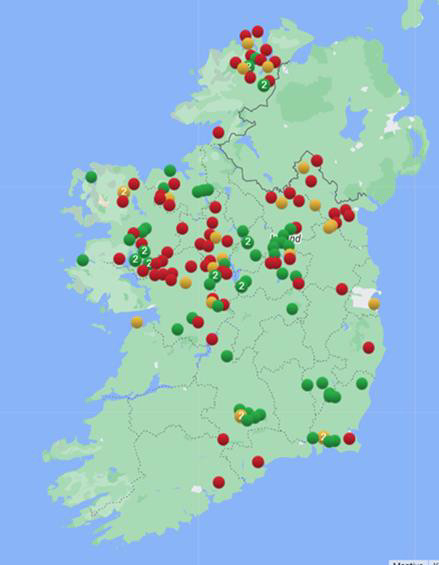

Samples from 176 flocks were submitted, of which 87 were positive and 20 were inconclusive. Of the positive samples 24 were heavy infestation, 22 moderate infestation and 31 low grade infestation. The 87 samples were distributed across counties Cavan (4), Cork (1), Donegal (19), Galway (15), Kildare (1), Longford (1), Louth (3), Mayo (10), Meath (2), Monaghan (3), Roscommon (14), Sligo (5), Tipperary (2), Waterford (1), Westmeath (4), Wexford (1) and Wicklow (1). The 20 inconclusive results came from flocks in counties Cavan (2), Clare (1), Donegal (3), Dublin (1), Galway (2), Mayo, (1), Meath (2), Monaghan (1), Roscommon (3), Sligo (1), Tipperary (1), Westmeath (1) and Wexford (1).
November 2022


Samples from 186 flocks were submitted, of which 95 were positive and 12 were inconclusive. Of the positive samples 20 were heavy infestation, 48 moderate infestation and 27 low grade infestation. The 95 samples were distributed across counties Cavan (3), Cork (8), Donegal (18), Dublin (1), Galway (14), Kerry (2), Kildare (1), Leitrim (3), Limerick (1), Longford (1), Louth (2), Mayo (15), Meath (7), Monaghan (4), Roscommon (3), Sligo (5), Tipperary (2), Waterford (3), Westmeath (1) and Wicklow (1). The 12 inconclusive results came from flocks in counties Donegal (1), Galway (3), Louth (1), Mayo (4), Roscommon (1), Sligo (1) and Tipperary (1).
There is always a need for caution when assessing the liver fluke status of Irish sheep flocks. As the sample size for some counties is small, farmers in these particular counties need to be cautious when interpreting the results of the survey as they relate to their areas. Additionally, the county associated with a batch of lambs is that where the flock of submission is registered. In a minority of cases, where the lambs had been purchased shortly before slaughter, the county associated with a batch will not reflect accurately where the batch of lambs spent its life. Farmers need to consider information from a range of sources when deciding the best management tool be avail of, be that dosing or avoidance of certain pasture at certain times. Further advice should be sought from your private veterinary practitioner.
Acknowledgements
Kate O’Keeffe, DAFM Blood testing lab, Cork
John Comerford, VPH, Kilkenny Local Office
Seamus Fagan, Athlone Regional Veterinary Laboratory
Colston and Mearns (2023) “Liver fluke in cattle and sheep: getting ahead of a rapidly adapting parasite” In Practice volume 45, Issue 6 21 July 2023 ([Articles & Chapters: fluke] AND [Journal: In Practice] : Search (wiley.com)) Accessed 22/08/2023

